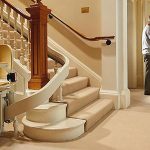Stair lifts to heaven… how one home aid can keep older people independent
Stair lifts are the single most important home adaptation that an older person can make to enable them to remain living independently. But how do you make sure you choose the right one for you, your home and your budget? Specialist advice websitewww.myageingparent.com looks at all the options you need to consider.
Given a choice, most of us would prefer to remain living independently in our own home for as long as we possibly can – not least because of the huge costs of going into a care home, and also because it can mean losing our immediate support network of friends and neighbours. Achieving that for anyone with two storeys (or more) in their home can depend upon one single adaptation: installing a stair lift. But should you buy… or rent? Do you need a curved design or straight one? New or reconditioned? Will it need an extra battery or not? With a joystick or toggle control? And who can you trust to install and maintain it?
“There are myriad options to choose from,” says www.myageingparent.com MD Deborah Stone, “And as some of them can be very expensive indeed, it’s well worth doing lots of homework before deciding. That said, time can sometimes not be on your side if someone is waiting to come out of hospital following a fall. But the biggest thing to remember is that – as expensive as it can be – it is still nowhere near the cost of moving home or into a care setting, and not as inconvenient as moving your bedroom downstairs. And the next most important thing to bear in mind is that – despite some people’s concerns about it changing the appearance of their home – it won’t affect the value, it can be readily taken out if you do decide to move in the future, and it can actually be a sales feature if the next purchaser also has mobility issues. A stair lift will not only help those who have reduced mobility – through arthritis or knee or hip pain perhaps – but also those with heart conditions, or breathing problems such as COPD, that make it dangerous to over exert oneself. Just as importantly, falling down stairs is the most common cause of injury amongst the older generation, often caused by muscle weakness or through eyesight or balance problems.’’
With all of this said, buying stair lifts for a home can still be a daunting task, so here’s what you need to consider before buying one for your home or a relative.
Do you need a straight or curved stair lift?
If you have curved staircases, then you will need to buy a curved stair lift which can go smoothly around corners. Curved stair lifts are generally more expensive than their straight stair lift counterparts, because detailed measurements are needed for the curved models.
How mobile is the person who is going to be using the stair lift?
The stair lift user will still need to be able to get on and off the stair lift: if they are unable to, then it is pointless getting one.
How narrow is your staircase?
If your home’s staircase is narrow, then you will need special stair lifts for narrow stairs. If you or the person riding on the stair lift is tall, there is the potential that the rider may knock their knees, in which case standing stair lifts are available too.
Are there objects on the staircase?
If there are doors, radiators or any other type of potential obstruction, then your stair lift will need a hinged track. This means that the track can be folded away from doorways to give other people clear access.
Is there a battery power source for your stair lift?
The last thing a user of a stair lift wants is for their home’s electricity to go out and for them to be stuck halfway up the stairs. To prevent this, you will need to ask the stair lift manufacturer whether there is an extra battery power source to prevent something like this from happening.
How dexterous are your hands?
If the stair lift user has problems with their hands and may not be able to work a normal stair lift remote control, then stair lifts which have joysticks and toggles may be a better option.
How should you take care of your stair lift?
Stair lifts need to be maintained and this advice should be given to you by the manufacturer from whom you are purchasing the stair lift. Before you buy a stair lift model, you need to ask about whether the stair lift comes with an insurance policy and what the cost of this would be as sometimes these policies are very pricy.
Have you thought about reconditioned stair lifts?
If you’re looking to trim costs, then a reconditioned stair lift could be your best option.
Both straight and curved reconditioned stair lifts are available and most of these stair lifts have been refurbished in the retailer’s factory, which should ensure that they have been properly fixed and looked at. Most renovated stair lifts should come with warranties that will cover any problems within the first year or so.
Do you need an outdoor stair lift?
If it has become more and more difficult for you to get up and down steps in the garden, then an outdoor stair lift could be your answer. Essentially, these are the same as indoor stair lifts, except that they are weather resistant.
Rented or purchased?
Depending upon your means, as well as your plans to remain in your home, you might consider renting a stairlift rather than purchasing one – several of the main suppliers offer this option.
“But perhaps the biggest single decision to be made,” concludes Deborah Stone, “is who you trust to install and maintain your stairlift. The cheapest option will not always represent the best value, while the most expensive one will not necessarily guarantee you the very best level of service. Often in these circumstances, it’s best to ask friends who have had one installed what their experiences have been, check out any online reviews that you or a family member can find, and ask at least three people to quote for the work.”





